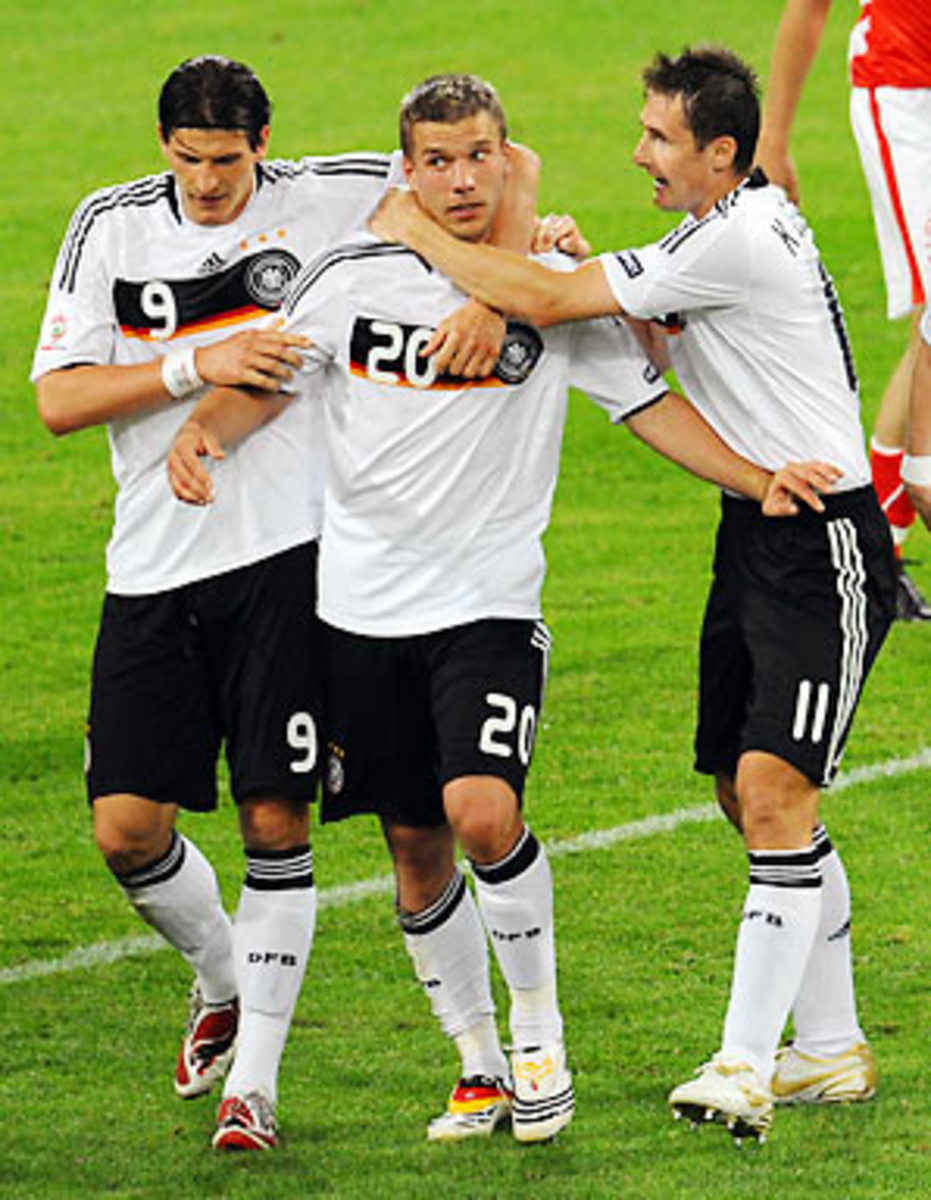Changing times: The death of 4-4-2
BASEL, Switzerland -- Remember 4-4-2? That basic formation you most likely played when you were kids? Four defenders in a line (maybe one of them might drop off to sweep), four midfielders in a line (the wide guys acting, effectively as wingers) and two forwards, also pretty much playing alongside each other.
How times have changed. Just look at the eight quarterfinalists at the 2008 European Championship. Portugal (Nuno Gomes), Croatia (Ivica Olic), Italy (Luca Toni), the Netherlands (Ruud van Nistelrooy) and Russia (RomanPavlyuchenko) all play with a single, central striker. Sometimes it's more of a target man type (Toni, van Nistelrooy), sometimes more of a mobile goal-sniffer (Olic), but the basic premise is the same.
Turkey has changed several schemes, but, in two of its three outings, Fatih Terim went for the lone big man (Semih Semturk or Mevlut Erdinc). Spain does play two up front, though -- in fact, David Villa tends to come from deep-lying positions. Which leaves Germany as the only side with two legitimate front men, Miroslav Klose and Mario Gómez.
Why the shift? When did 4-4-2 become outdated? Theories abound, of course. For a start, it should be noted that lone striker formations are nothing new: For a very long time, right up until the 1980s, the center-forward-plus-wingers formation was fairly widespread (South America was a different story).
Beyond that, I don't really know. Obviously, you want to play to your strengths and, if you have two outstanding strikers, it generally makes sense to play them together. Especially if you don't have quality attacking midfielders.
But generally speaking, a 4-4-2 works best when the wide men in midfield get forward, stretching the opposition, pinning the fullbacks and delivering service into the middle. To do that, however, you need top-notch, natural wide men. And the fact is that old-school wingers (with a few notable exceptions) don't seem to exist at this tournament (apart from Portugal, which is loaded in that department)
Germany is a perfect example of this. Against Croatia, it had to play Clemens Fritz, a recycled fullback, and Lukas Podolski, normally a striker, out wide with disastrous results. Against Portugal in Thursday's quarterfinal, it plans to abandon the two-striker set-up altogether, opting for a 4-2-3-1. (Which, given the absence of wingers, still doesn't really solve the problem).
What's more, even old-school wingers wouldn't really work in a 4-4-2. Back in the day, you could have an all-out winger and get away with it, knowing the fullback behind him was primarily a defender. Now, however, teams want their fullbacks to attack (in order to generate the coveted "extra man" in midfield) which, in turn, means the wide men have to do that much more defending (or, at least, provide cover when the fullback bombs forward).
So if you happen to be Portugal, for example, you don't want your wingers having to worry too much about their defensive duties. Thus, you put together a 4-2-3-1 system, with the pair in front of the back four deputized to shift wide when necessary to cover for the advancing fullback. Although to do that, you have to sacrifice one of your strikers.
Of course, fewer strikers doesn't necessarily mean fewer goals. But it does, to some degree, mean a more packed midfield and less room in which to play. That isn't necessarily a bad thing if you have the kind of close-control and passing ability to operate in tight spaces.
And it can also be positive for your lone front man. He may feel the solitude, but he'll probably enjoy the fact that the absence of a teammate creates more space for him to run into.
When you think about it, there's a lot of Yin and Yang in tactics. Every move has a specific counter-effect. Close space here, open things up there. Remove a player up front and you'll have less offensive punch but more space in which to operate. The trick really is -- predictable as it sounds -- creating a system which suits the players at your disposal. And not the other way around.
Kudos to Marco van Basten. But if you even begin to suggest that the Netherlands have anything to do with "Total Football," you either don't know what you're talking about or you haven't seen the Dutch play. Just because the players wear orange and score lots of goals doesn't make it Total Football. That was a very specific system of play developed by Rinus Michels and then Stefan Kovacs.
The next time some fool tells you van Basten's team is playing "Total Football," tell them to go watch the 1972 European Cup Final between Ajax and Inter Milan. That was the highest expression of "Total Football."
Does this Dutch side defend high up the pitch and rely heavily on the offside trap? No. Do both fullbacks bomb forward? No. Are the central defenders contributing to the attacks? No. Are the central midfielders coming forward and switching positions with the front men? No. Does the side press collectively? No. So it's not "Total Football" -- case closed.
Van Basten's Netherlands is a very effective counterattacking team that masks its weaknesses very well and exploits its strengths. Which is what good teams do. In fact, it's what the Dutch did when they won the Euros back in 1988, when they were coached by Michels.
Yes, the guy who invented "Total Football" realized some 20 years ago that his own scheme was outdated and came up with a way of playing which allowed the Netherlands to win major silverware. Van Basten may not be a managerial genius like Michels (not yet anyway), but he is clever enough to know that what he's doing has nothing to do with Total Football.






